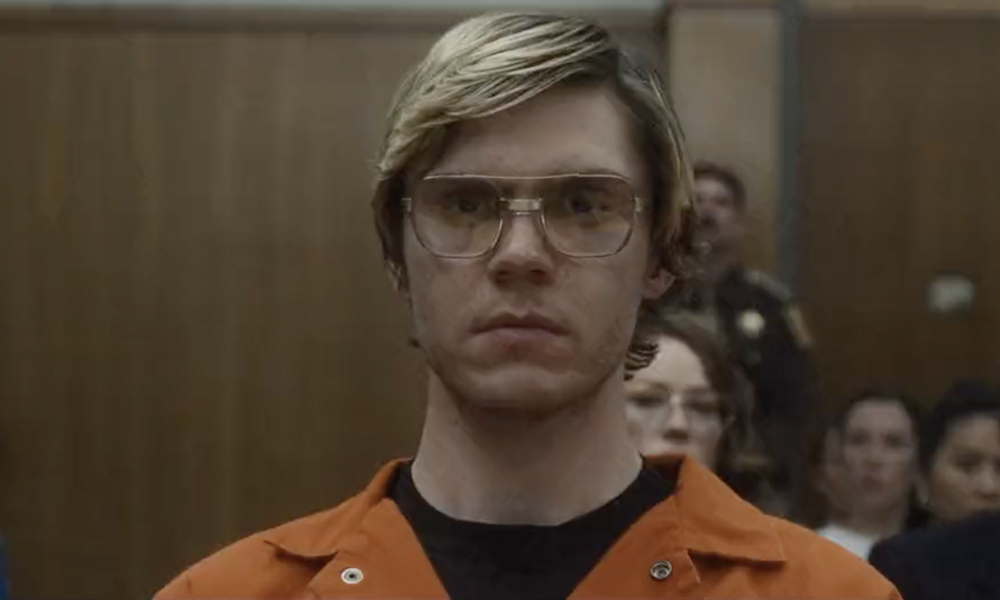Ryan Murphy’s latest true crime dramatization may not be worth the damage it causes…
If you’re a true crime fan, you know there’s no shortage of books, documentaries, podcasts and original reporting dedicated to the victims of violent crimes and the people who commit those crimes. At the same time, we know that cases that get the most attention are usually ones that are committed against white, middle class, cisgender people. Meanwhile hate crimes, including murders of gay, trans and non-binary people are on the rise. Queer Crime is a monthly column focusing on true crime with an LGBTQ+ spin whether it’s the victim or the perpetrator.
This month, we’re exploring the criticism of Ryan Murphy’s latest Netflix series Dahmer – Monster: The Jeffrey Dahmer Story. One of the most infamous serial killers in American history, Jeffrey Dahmer was arrested, convicted and sentenced to life in prison for the murders of 17 young men and boys between 1978 and 1991. He served only a few years of his sentence before he was beaten to death by another inmate in the Columbia Correctional Institution in Wisconsin. Like we’ve seen with other long-dead serial killers like Ted Bundy and Richard Ramirez, Hollywood is still turning Dahmer’s horrific crimes into content.
Dahmer – Monster: The Jeffrey Dahmer Story is a 10-episode limited series notable for its highly accurate re-enactments of well-documented events in the Dahmer case. The grisly details like how Dahmer lured his victims before drugging, murdering, and disposing of their remans, are all part of the series, but the real focus is systemic failures that allowed Dahmer to keep killing for over a decade, and the impact his crimes had on his family, his community, and the families of his victims.
While there is a lot of attention paid to Dahmer, Murphy’s goal was to center the voices of the victims and he takes care never to show the events from Dahmer’s point of view. The intention may not have been to show the story according to Dahmer, but the series is still getting a lot of criticism for coming across as “exploitative”, “insensitive” and “cruel” towards the families of the victims who would prefer it was never made.
This is far from the first time the Dahmer case has been translated onto the screen. In 2002, Jeremy Renner played the title character in Dahmer, which attempted to depict some of the psychological motivations behind his crimes. In 2017, Ross Lynch played teenage Dahmer in the adaption of Derf Backderf’s graphic novel, My Friend Dahmer. There has also been countless docuseries episodes and feature documentaries chronicling Dahmer’s childhood, family life, and descent into cannibal and crazed murderer.

Meanwhile, real-life families of victims are still out there grappling with what happened to their loved ones. They have to navigate their lives knowing there might be another director analyzing their trauma and how it might translate to the big screen. While production companies claim to care about the victims first and foremost, they don’t show that by communicating their intentions with victims’ loved ones. In fact, in many cases, victims’ families find out about the project the same way as everyone else—with the release of the first trailer.
In 1992, Rita Isbell, whose brother Errol Lindsey was killed by Dahmer, gave a victim impact statement in court. She screamed at Dahmer while he sat silently, unable to look at her. The scene is recreated word-for-word in Dahmer – Monster. While some have praised the powerful performance and attention to detail in the scene, the Isbell family has made it clear they aren’t happy about the series as a whole or the fact that such a traumatizing experience has been recreated for the entertainment of Netflix subscribers. Rita’s cousin re-tweeted a side-by-side comparison of the scene vs. real-life and asked how many more on-screen versions of the Dahmer case the world needs.
In addition to a greater focus on the victims, Murphy’s series also recreates events that call out racist and homophobic assumptions police officers made that led to the death of at least one victim, 14-year-old Konerak Sinthasomphone. Dahmer had already drugged Sinthasomphone and injected hydrochloric acid into his brain, but Sinthasomphone managed to escape Dahmer’s apartment and was found wandering around outside by three women, who called the police. The women believed Sinthasomphone appeared to be a child and needed medical assistance, but Dahmer was able to convince the police that Sinthasomphone, who was bleeding and unable to speak, was his boyfriend and he was just drunk.
The police chose to believe Dahmer’s story and let him take Sinthasomphone back to his apartment, where he was later killed. The three women followed up, but the cops brushed them off insisting it was a “boyfriend-boyfriend thing” and there was nothing they could do. The Dahmer – Monster series shows the two police officers—who were fired, but later reinstated—making homophobic remarks and clearly not doing their due diligence to ensure Sinthasomphone was okay. In this scene and various others, the series demonstrates how Dahmer used homophobia and racism to his advantage by targeting victims in marginalized gay and BIPOC communities.
Overall, the main issues with the Dahmer – Monster series are the same issues that plague the true crime genre as a whole. Despite the focus on systemic failures and its attempt to give victims a voice in a more meaningful way than any other Dahmer series, the general sentiment is that it’s becoming harder and harder to justify the existence of a series that puts a dead serial killer back in the spotlight at the expense of the loved ones of his victims.
The LGBTQ+ community is still facing violence at an alarming rate. Law enforcement and the justice system are still failing them in a number of different ways. There are plenty more cases that don’t get any attention and lots of progress still to be made—so maybe it’s time to leave Jeffrey Dahmer’s crimes in the past, let his victims rest, and focus on eliminating the prejudices that make gay, BIPOC communities so vulnerable in the first place.
For more of Courtney Hardwick’s fascinating QUEER CRIME series click here.






POST A COMMENT